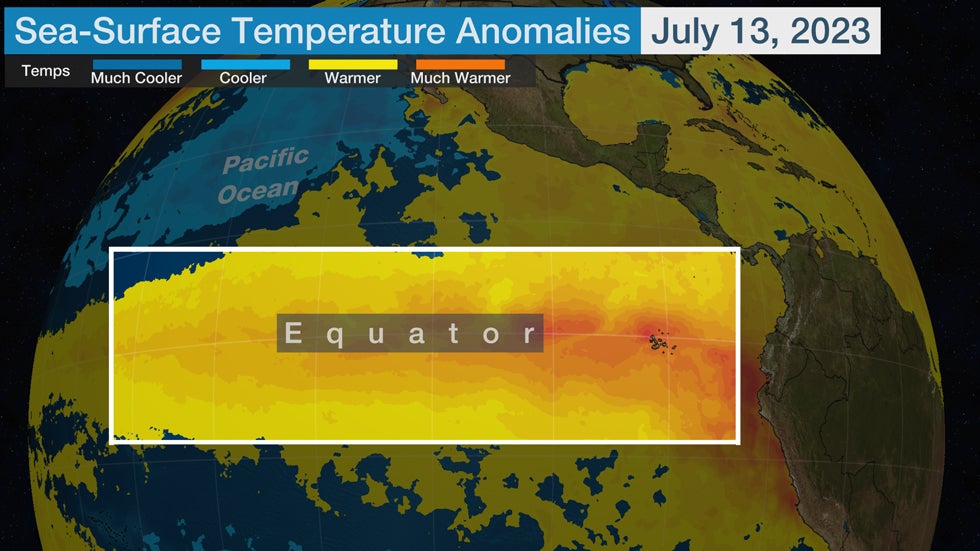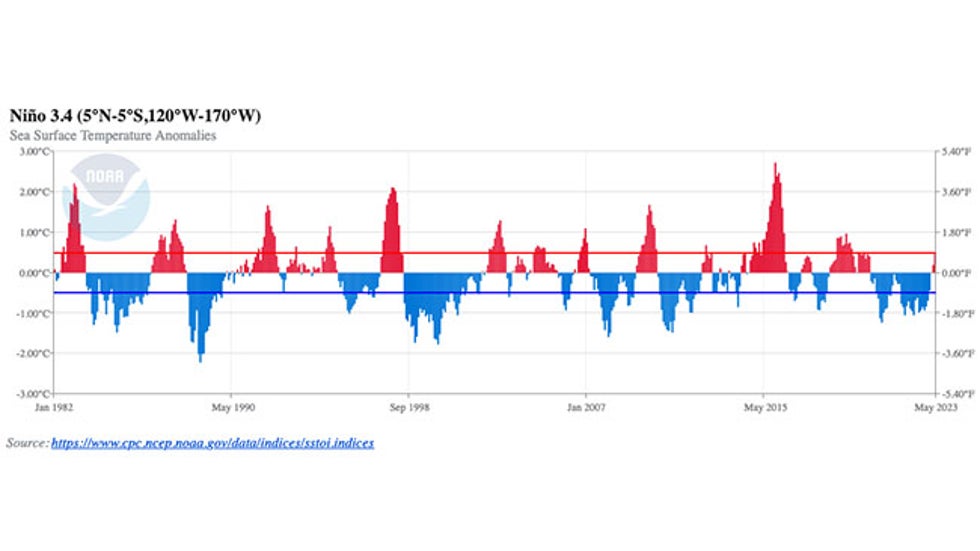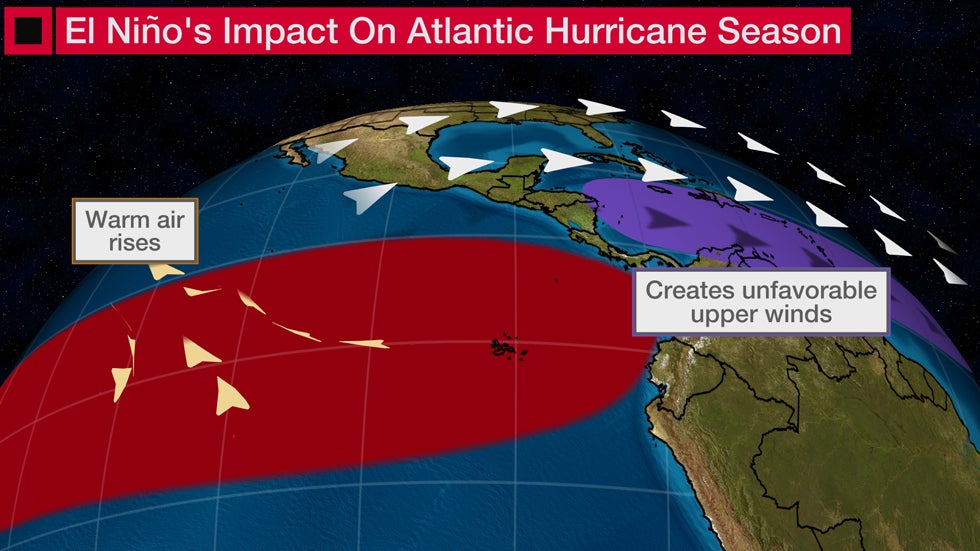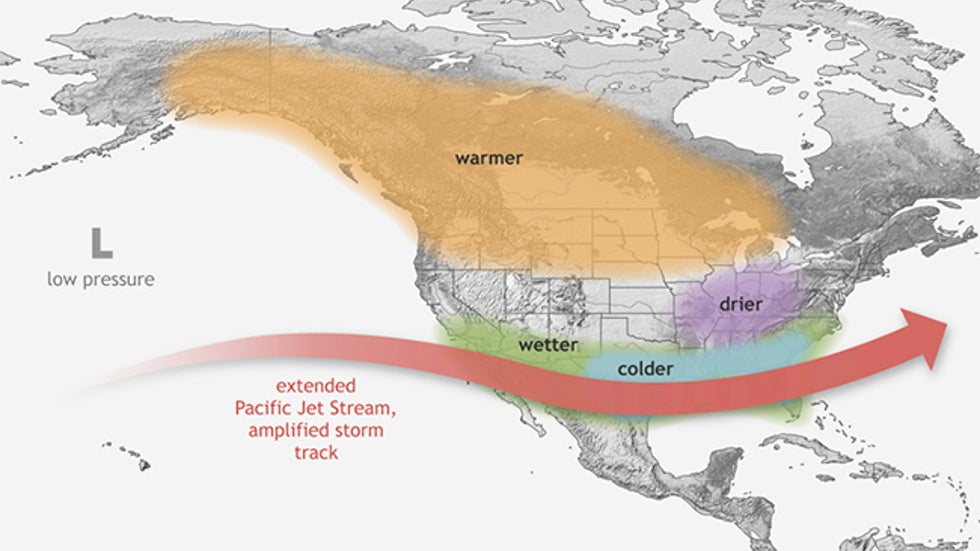Jon Erdman and Chris Dolce
El Niño is expected to intensify in the coming months and could become moderate to strong, possibly influencing hurricane season and the weather we see this winter, according to a just-released monthly update from NOAA.
Here's are the main takeaways from the July update.
1. Weak El Niño conditions remain in place after the event was officially deemed underway a month ago. It's 90% likely El Niño will continue through winter.
2. El Niño is forecast to grow in strength through fall and winter, most likely peaking in the moderate to strong intensity range. NOAA says there is an 81% chance the event will be at that intensity between November and January. El Niño and its counterpart La Niña usually peak in late fall or winter before diminishing the following spring.
3. There is a 1 in 5 chance this El Niño becomes "historically strong," rivaling 2015-'16 and 1997-'98 events, NOAA said. In general, the stronger El Niño becomes the more influence it can have on global weather patterns.
What is El Niño? An El Niño is a periodic warming of a strip of water straddling the equator in the Pacific Ocean, as shown in the general area highlighted in the map below.
NOAA declares an El Niño has developed when sea-surface temperatures in a certain region of the equatorial Pacific Ocean have reached at least 0.5 degrees Celsius (0.9 degrees Fahrenheit) above average for at least a month and are accompanied by changes in the atmosphere.
That warming is occurring both at the surface and a few hundred meters below the surface, supporting the developing El Niño.

When was the last El Niño? This is the first El Niño in four years. This strip of water has actually been cooler than average over much of the past three years, which is known as a La Niña. But that ended by March, and water temperatures in this area have now warmed above the El Niño criteria.
 Sea-surface temperature anomalies in the region we monitor for El Niño and La Niña from 1982 through May 2023. Positive anomalies are shown in red, while negative anomalies are shown in blue. The +/- 0.5 degree Celsius thresholds for El Niño and La Niña are shown by the horizontal red and blue lines, respectively.
Sea-surface temperature anomalies in the region we monitor for El Niño and La Niña from 1982 through May 2023. Positive anomalies are shown in red, while negative anomalies are shown in blue. The +/- 0.5 degree Celsius thresholds for El Niño and La Niña are shown by the horizontal red and blue lines, respectively.Potential Impacts
While not the only influence, an El Niño can eventually steer weather patterns in parts of the world, including the tropics and the U.S. The stronger it is, the more influence it could have. Here are some possible impacts El Niño could have this hurricane season and in winter.
Hurricane Season
In El Niño hurricane seasons, stronger shearing winds often occur over at least the Caribbean Sea and some adjacent parts of the Atlantic Basin.
This tends to limit the number and intensity of storms and hurricanes, especially if the El Niño is stronger, as we investigated in a March article.
However, separate outlooks from Colorado State University, NOAA and The Weather Company noted a warmer Atlantic Ocean may work against the influence of El Niño in 2023.
Storms this season could get squashed in the southern Gulf of Mexico and Caribbean Sea due to El Niño-enhanced wind shear and sinking air, while more typical activity roams the rest of the Atlantic from off western Africa to the Bermuda Triangle.

Winter 2023-24
Most El Niños hit their peak in late fall or winter and thus have their strongest influence on weather patterns in the colder months.
The classic El Niño winter is rather warm from Alaska into western and central Canada and then into the northern tier of states from the Pacific Northwest to the western Great Lakes.
It tends to be colder and wetter than average through much of the southern U.S., particularly from Texas to the Carolinas. We found that some cities in the Southwest, Southern Plains and mid-Atlantic have their snowiest winters during El Niño.
Other factors can and do influence winter weather patterns, including the polar vortex. But if this El Niño becomes strong, this may be the general picture to expect next winter.
 Typical impacts during an El Niño from December through February in North America.
Typical impacts during an El Niño from December through February in North America.Global Temperatures
NOAA's ENSO blog noted the warmest year of any decade tends to occur during an El Niño.
But the planet's warming now means that even recent La Niña years have become warmer than El Niño years in past decades, as the graph below illustrates.
NOAA's calculations as of their June report give about a 20% chance that this will be the warmest year on record and an 90% chance it will rank at least in the top five.
 Monthly global temperature anomalies (degrees Celsius) from 1980 through March 2023 in El Niño months (red), neutral months (gray) and La Niña months (blue), relative to the 20th century (1901-2000) average. Each month since 1979 has been at least somewhat warmer than that 20th century average.
Monthly global temperature anomalies (degrees Celsius) from 1980 through March 2023 in El Niño months (red), neutral months (gray) and La Niña months (blue), relative to the 20th century (1901-2000) average. Each month since 1979 has been at least somewhat warmer than that 20th century average.MORE ON WEATHER.COM:
2023 Hurricane Season Outlook
How El Niño Could Influence Hurricane Season
How El Niño Could Influence Next Winter In California
When Was The Last 'Quiet' Hurricane Season?
Jonathan Erdman is a senior meteorologist at weather.com and has been an incurable weather geek since a tornado narrowly missed his childhood home in Wisconsin at age 7. Follow him on Twitter and Facebook.
Chris Dolce has been a senior meteorologist with weather.com for over 10 years after beginning his career with The Weather Channel in the early 2000s.
The Weather Company’s primary journalistic mission is to report on breaking weather news, the environment and the importance of science to our lives. This story does not necessarily represent the position of our parent company, IBM.
The Weather Company’s primary journalistic mission is to report on breaking weather news, the environment and the importance of science to our lives. This story does not necessarily represent the position of our parent company, IBM.

No comments:
Post a Comment